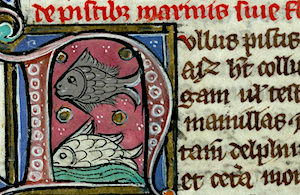The gentleman-limner John White took part in England's second voyage to the New World in 1585, whose aim was to plant a colony in Virginia. The reason for his presence on board is well documented. In a manuscript dated circa 1584-1585 entitled Inducements to the Liking of the Voyage intended towards Virginia in 40. and 42. degrees, Richard Hakluyt suggested that the expedition needed, among the tradesmen on board, “a skilful painter [...] which the Spaniards used commonly in all their discoveries to bring the description of all beasts, birds, fishes, townes, &c.” Following a tradition attributed to the Spanish, John White was thus endowed with a mission to “drawe to life all strange birds beastes fishes plantes hearbes Trees and fruictes and bring home of eache sorte as nere as you may”. John White's drawings “to life” now appear clearly as having been mediated through classical knowledge and previous illustrated publications such as Conrad Gessner's Historia animalium. Besides, the finesse of many of White's neat and meticulous drawings indicates that they were quite probably the result of substantial posterior working up, thus not qualifying as ad vivum per se, as was common in the early modern period.
Among the British Museum's seventy-five drawings in watercolour on paper presumably made by John White and assembled in an album whose title-page describes them as “pictures of sondry things collected and counterfeited according to the truth”, fourteen of them depict fish specimens (to which may be added other pictures still, including those describing the Indians' “manner of fishing” or “broyling fish”). The fish watercolours therefore amount to more than a third of all drawings of flora and fauna in the album. From this point of departure, the paper I am proposing explores the reason why fish feature so prominently among White's images. I argue that in addition to their practical, scientific and commercial purposes, these drawings also testify to a courtly and artistic presentation of their subjects. I will therefore adopt a medium-specific approach of fish depiction in the British Museum album. My paper contends that the development of watercolour (or “limning” as it was then known in England) as a pictorial medium gave rise to a conception of ichthyological illustration which differed rather markedly from other types of then popular media (such as engraving). The colourful and luminescent quality of pigments used in watercolour seems to have been explored to the full by John White in his depiction of fish, and may also partly account for his choice of species and specimens, thus adding an aesthetic and distinctly pictorial dimension to the transmission of ichthyological knowledge.
- Poster

 PDF version
PDF version

